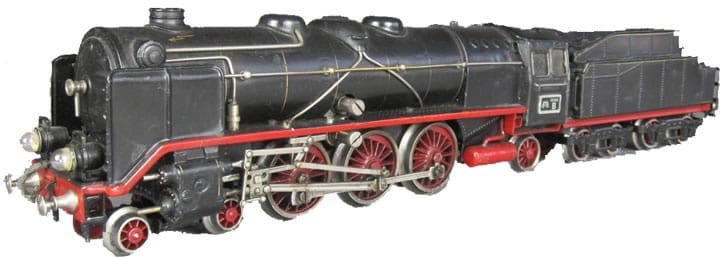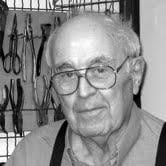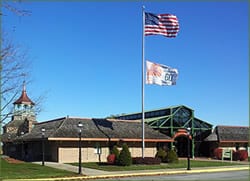My Greatest Find
By Michael A. Cann, TCA # 57-201
(Written about 1994, published posthumously by permission)
Editor’s Note: This article may be regarded as following an article with the same name published here in 2008 by Mike Stella, yet this was actually written over a decade earlier, and reflects the satisfaction many members feel over a particular toy train. We are indebted to Mr. Cann’s widow Anne for sharing this article.
Michael Cann joined TCA in 1957, one of the early members who was subsequently designated an Honor Roll member until his passing in 2012. His collecting interests were very diverse and included samples of many different American and European manufacturers in all gauges.
Trains and train collectors greatly enhanced his life. Nothing would deter him from attending the local NETCA meetings or York. Train collectors were among his best friends.
When the idea of creating a toy train museum initially arose, he did not think it was a promising idea. He later changed his mind and found the National Toy Train Museum and Library a wonderful institution and donated items to both.
The story exemplifies Michael’s zeal for the hunt for a sought after special item in those days when one did it through newspaper ads and signs in the local neighborhood and how some of those dreams turned out.
Upon his passing, mourners were encouraged to make a contribution to TCA in his memory. His Greatest Find is still on the shelf in his home in Amherst, MA.
=================
My greatest find occurred as long ago as 1957, when I was a train enthusiast, but not yet a collector.
My father had started me with a small “0” gauge set in Germany when I was only three years old. When immigrating to the United States in 1939, I was able to bring these trains along. Included was a Märklin catalog for 1938-39, in Dutch.
A used Lionel locomotive was soon added and for years it pulled a few European cars.
The Märklin catalog offered tantalizing glimpses into a world of toy trains which I had never seen. On page 24, there were several dramatic illustrations of the Märklin “0” gauge Pacific.
In the meantime World War II started, making such things seem forever out of reach. I would never have expected such an expensive toy anyway.
Eventually the war ended. I was going to college, getting married and starting a family. I finally did see several Märklin Pacifics but they were either too expensive or not for sale.
Then it happened! In response to an ad in a hobby magazine, I was offered an “0” gauge Märklin Pacific in trade. It was described as “having some rust on the trucks and needing a little work.”
By this time I was in graduate school, but my childhood fantasy about the engine on page 24 of the Märklin catalog was very much alive. Thus I was thrilled and agreed to make the trade. I waited expectantly for three weeks for the package to come. Finally the magic day came and the package arrived. When I unwrapped the treasure, it did have rust on the trucks, but that was the least of it. The engine had obviously had a very hard life and had probably literally been thrown into the toy box repeatedly. It was a real mess. But it had cost only about $25 in trade. And I’m pretty handy.
The problems were extensive. Although the drive wheels were intact, (they’re cast iron), all truck and tender wheels had severe white metal disease. The leading truck was missing altogether. The cab as well, as one smoke deflector had been damaged and inexpertly re-soldered. One cylinder had almost completely separated from the frame, probably because the engine had been dropped. Three of the four buffers were gone. The smoke box handle was gone. The head light bulbs were lost.
The coal from the tender was missing. The engine seemed to have been pickled with auto engine oil which was oozing from the motor. One side was covered by countless tiny white specks, the kind one gets when shaking out a paint brush. I’m sure there were between five hundred and a thousand, all on the side of the engine now facing the camera.
Still I was enthralled. I had been looking at the catalog picture of this engine for sixteen years. Finally I had one. Somehow I would manage to rehabilitate this wonderful find. I made a space for the engine among the books on my desk. I’m not sure that it was the best way to sharpen my study habits.
Bit by bit I started to clean up my treasure. The engine oil yielded to a judicious application of gasoline. Some of the surface oiliness had evidently preceded the paint spots. Thus it proved possible to gradually pop them off, one by one with a dull paring knife without damaging the paint underneath. For years I would find stray spots that I had overlooked.
I began to investigate the possibility of finding replacement parts. Someone directed me to an importer who was handling Märklin trains. The importer permitted me to go to his warehouse and look in the parts supplies. There in a small drawer, I found all the wheels and buffers that I needed. A near miracle had occurred, or so I thought. The warehouseman told me that he would have to get permission from the importer to sell me the parts. I was to call back in a week. All seemed fine and I left secure in the knowledge that most of the necessary parts were in my grasp. Little did I suspect what was going to happen next. When I called back, the warehouseman informed me that the importer had died unexpectedly. For the moment, nothing could be sold at all. The business was tied up in the estate. But I could check back after a few weeks. As it turned out, the checking back was to continue for seven months. Finally the estate was settled and I was able to purchase the required parts at an increased price. Someone else was now in charge.
Next I made a leading truck without ever having seen an original. I became proficient at pressing wheeling onto axles without proper tools. After I joined the Train Collectors Association, an older collector offered me a “correct” leading truck which turned out not to fit. A few years later, the right one finally did come along.
I obtained light bulbs from a broken Märklin signal. I actually repaired one of them by gluing the glass globe back into the base. A smoke box door handle became available as did a Märklin direct controller which I needed to run the engine.
After repeated trials, I became adept at imitating original Märklin coal. Again I had never examined an original. In time I realized that Märklin used real crushed coal embedded in black sealing wax.
Over the past thirty-seven years, I’ve made other great finds. Still my favorite is this scarred old veteran which, with its many dents and scratches, its extensive and occasionally crude repairs, remains “My Greatest Find.”
And I did complete graduate school on time.
========================
For additional details on Mr. Cann’s life, go here.
Comments may be sent to Anne G. Cann, his widow, at [email protected]








